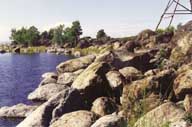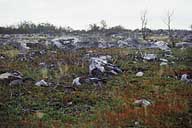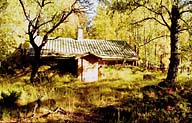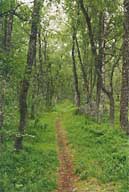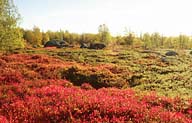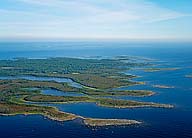Valsörarna
In the autumn and spring Valsörarna attracts birdwatchers
who place rings on and count migratory birds. In September and
October one of the major events of the autumn takes place - ringing
the night-flying Tengmalm's owl (Aegolius funereus).
In the spring migrating rough-legged buzzards (Buteo
lagopus) and black-throated divers (Gavia
arctica) are counted by the thousands. The black guillemot
(Cepphus grylle) and common gull (Larus
canus) are typical birds for this archipelago. The scientific
association Ostrobothnia Australis owns a birding station on Valsörarna.
Valsörarna's landmark, the red-painted 36-metre tall
iron lighthouse, was designed in 1886 in Paris by the same firm
that later built the Eiffel Tower. The lighthouse had long been
in the planning but did not become reality until five vessels
sank on a single night in the waters outside Valsörarna.
The plan was to place the lighthouse on Äbbskär, but
since no appropriate location could be found it was built on Storskär
instead, where there is an outcrop. A road called "Kärleksstigen"
("the love trail") was built to transport the sections
of the lighthouse from Äbbskär to Storskär. The
lighthouse has not been staffed since 1964. The existing coast
guard station was first used in 1984, but the history of the coast
guard on Valsörarna goes back to the 1940s.
A memorial tablet in a cairn is by the trail on the heather-covered
moor on Äbbskär. It was erected in memory of the Russian
soldiers who died here from cold and exhaustion when they crossed
the Kvarken archipelago under the leadership of General Barclay
de Tollys. The story goes that the inhabitants of Valsörarna
were tired of running into bones and skulls so they gathered together
all the skeletons parts in one place and built a cairn on top
of the pile.
Valsörarna was declared a bird refuge in 1948. In
1977 this was expanded to include the already protected Björkögrunden,
which is south of Valsörarna, to become the Valsörarna-Björkögrunden
nature reserve. The entire area covers 17,200 hectares of water
and 600 hectares of land. For everyone except Björköby
residents a general prohibition against going ashore is in effect
during the breeding season from 1 May to 31 July, with the exception
of specific locations. One of these places is the coast guard
station at Äbbskär. Throughout the area there is a speed
limit of eight knots. Boaters must stay within the marked channels.
| 
